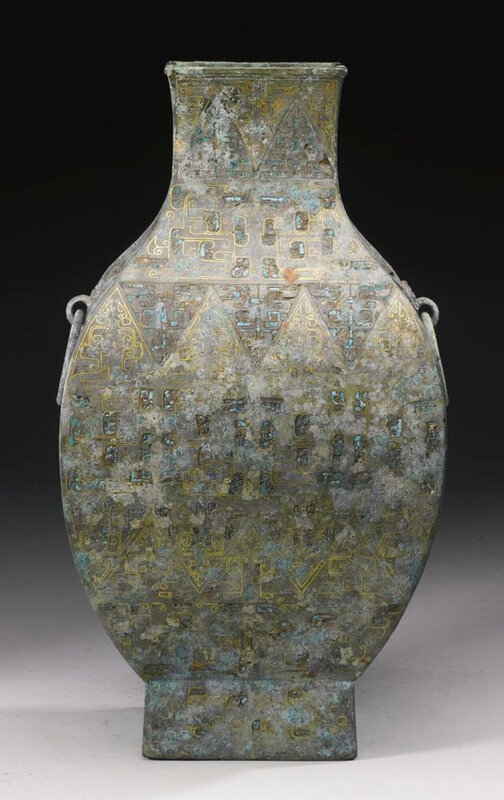A rare and large gold and malachite-inlaid bronze ritual wine vessel (fanghu), Warring States Period (475-221 BC)
Lot 100. A rare and large gold and malachite-inlaid bronze ritual wine vessel (fanghu), Warring States Period (475-221 BC). Height 17 3/4 in., 45.1 cm. Estimate 30,000 — 50,000 USD. Lot sold 116,500 USD. Photo Sotheby's
of pear form and square section, rising to a tall neck with everted lipped rim and supported on a straight-sided base, a pair of mask handles to either side with pendent ring handles, decorated overall with an intricate geometric design of three rows of a zigzag framework filled with symmetrical configurations of angular scrolls and hooks alternating with bands of C-scroll confronting dragon-head profiles, the pattern delineated by finely inlaid gold wire and accented with small pieces of inset malachite, wood stand, Chinese hardwood box (3).
Property from The Masaki Museum of Art.
Provenance: Japanese Collection, acquired before the 1960s.
Exhibited: Chūgoku senkoku jidai no bijutsu, Osaka Municipal Museum of Art, Osaka, 1991, cat.no. 57.
Chūgoku Inshū dōki ten, Takashima Department Store, Nihonbashi, Tokyo, 1958, cat. no. 76.
Kodai Chūgoku seidōki meihin ten, Shinsaibashi Daimaru Department Store, Osaka, 1960, cat. no. 54.
Literature: Chinese Art of the Warring States Period, Osaka Municipal Museum of Art, Naniwa Publishing, Osaka 1991, p.59, no. 169.
Note: Examples of finely inlaid fanghu vessels of this size and decoration are very rare. Known related examples seem to be most often decorated with an overall diamond pattern. There is a decagonal hu decorated with a similar zigzag pattern dated to the 5th century BC, illustrated Jenny So, Eastern Zhou Bronzes in the Arthur M. Sackler Collections, Washington D.C. 1995, no. 45, pp. 261-263.
Other examples of inlaid fang hu but with designs of a diagonal layout, include one excavated in Shanxian, Henan province and now preserved in the National Museum of China, Beijing, included in the exhibition The Great Bronze Age of China, New York, 1980, pl. 73, fig. 2; and one in the Freer Gallery of Art, Washington, D.C., published in John Alexander Pope et al., The Freer Chinese Bronzes, Washington D.C., 1967, vol. I, pl. 94. A final comparison in the Hebei Provincial Museum is illustrated in Zhongguo qingtongqi quanji, vol. 9, Beijing, 1997, pl. 155, fig. 3. A fanghu with diagonal and bossed decoration from the Albright Knox Museum was sold in these rooms, 19th-20th March, 2007, lot 508.
Sotheby's. Fine Chinese Ceramics & Works of Art, New York, 11 september 2012

/https%3A%2F%2Fprofilepics.canalblog.com%2Fprofilepics%2F1%2F0%2F100183.jpg)
/https%3A%2F%2Fstorage.canalblog.com%2F03%2F02%2F119589%2F96711876_o.jpg)
/https%3A%2F%2Fstorage.canalblog.com%2F11%2F31%2F119589%2F94773502_o.jpg)
/https%3A%2F%2Fstorage.canalblog.com%2F20%2F83%2F119589%2F94772815_o.jpg)
/https%3A%2F%2Fstorage.canalblog.com%2F26%2F72%2F119589%2F75604929_o.jpg)
/https%3A%2F%2Fstorage.canalblog.com%2F59%2F60%2F119589%2F26458628_o.jpg)








/image%2F1371349%2F20240407%2Fob_35c671_435786660-1647098469393499-37215121468.jpg)
/http%3A%2F%2Fstorage.canalblog.com%2F34%2F15%2F119589%2F129831053_o.jpg)
/http%3A%2F%2Fstorage.canalblog.com%2F04%2F42%2F119589%2F129831017_o.jpg)
/http%3A%2F%2Fstorage.canalblog.com%2F09%2F92%2F119589%2F129819533_o.jpg)